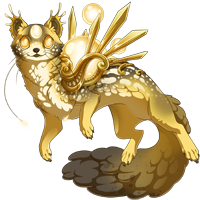

Helios
(#26828401)
all-seeing, far-shooter, most gracious
Click or tap to view this dragon in Predict Morphology.
Energy: 48/50

Expand the dragon details section.
Collapse the dragon details section.
Personal Style
Apparel










Skin

Scene

Measurements
Length
2.93 m
Wingspan
3.47 m
Weight
363.35 kg
Genetics
Obsidian
Iridescent
Iridescent
Saffron
Shimmer
Shimmer
Banana
Thylacine
Thylacine
Hatchday
Breed
Eye Type
Level 10 Tundra
EXP: 11006 / 27676



STR
36
AGI
11
DEF
14
QCK
21
INT
11
VIT
14
MND
11
Biography

Helios
Helius or Ἠέλιος
the sun
Helius or Ἠέλιος
the sun
Helios is the god and personification of the Sun from ancient Greek myth, often depicted in art with a radiant crown and driving a horse-drawn chariot through the sky. He was a guardian of oaths and also the god of sight.
Helios is seen as both a personification of the Sun and the fundamental creative power behind it and as a result is often worshiped as a god of life and creation. Homer described Helios as a god "who gives joy to mortals" and other ancient texts give him the epithet "gracious" (ἱλαρός), given that he is the source of life and regeneration and associated with the creation of the world. One passage recorded in the Greek Magical Papyri says of Helios, "the earth flourished when you shone forth and made the plants fruitful when you laughed and brought to life the living creatures when you permitted."
Helios is also sometimes conflated in classical literature with the highest Olympian god, Zeus. Helios is referred to as Zeus' eye, or clearly implied to be. For instance, Hesiod effectively describes Zeus's eye as the Sun. This perception is possibly derived from earlier Proto-Indo-European religion, in which the Sun is believed to have been envisioned as the eye of *Dyḗus Pḥatḗr (see Hvare-khshaeta). An Orphic saying, supposedly given by an oracle of Apollo, goes: "Zeus, Hades, Helios-Dionysos, three gods in one godhead!" When quoting this in his Hymn to King Helios, Emperor Julian substituted the name Dionysus with Serapis, whose Egyptian counterpart Osiris was identified with Dionysus. On the basis of this oracle, Julian concluded that "among the intellectual gods, Helios and Zeus have a joint or rather a single sovereignty."
Helios is usually depicted as a handsome young man crowned with the shining aureole of the Sun who drove the chariot of the Sun across the sky each day to Earth-circling Oceanus and through the world-ocean returned to the East at night. In the Homeric Hymn to Helios, Helios is said to drive a golden chariot drawn by steeds named Abraxas and Therbeo; and Pindar speaks of Helios's "fire-darting steeds". According to Eumelus of Corinth the male trace horses are Eous ("by him the sky is turned") and Aethiops ("as if faming, parches the grain") and the female yoke-bearers are Bronte ("Thunder") and Sterope ("Lightning"). Still later, the horses were given fire related names by Ovid: Pyrois ("the fiery one"), Aeos (Eous), Aethon ("blazing"), and Phlegon ("burning"). The imagery surrounding a chariot-driving solar deity is likely Indo-European in origin and is common to both early Greek and Near Eastern religions. The earliest artistic representations of the "chariot god" come from the Parthian period (3rd century) in Persia where there is evidence of rituals being performed for the sun god by Magi, indicating an assimilation of the worship of Helios and Mithras.
Helios is the son of Hyperion and Theia or Euryphaessa or Aethra. Homer in the Odyssey calls him Helios Hyperion ("the Sun up above"), with Hyperion used in a patronymic sense to Helios. In the Odyssey, Theogony and the Homeric Hymn to Demeter, Helios is once in each work called Ὑπεριονίδης, Hyperionides ("the son of Hyperion") and this example is followed by many later poets (like Pindar), who distinguish between Helios and Hyperion.
The female offspring of Helios were called Heliades. The Greek sun god had various bynames or epithets, which over time in some cases came to be considered separate deities associated with the Sun. Among these is Hyperion (superus, "high up"), Elektor (of uncertain derivation, often translated as "beaming" or "radiant", especially in the combination elektor Hyperion), Phaëton "the radiant", Terpsimbrotos ("gladdens mortals"), and Hekatos (also Hekatebolos "far-shooter", i.e. the sun's rays considered as arrows).
The island of Rhodes was an important cult center for Helios, one of the only places where he was worshipped as a major deity in ancient Greece. The worship of Helios at Rhodes included a ritual in which a quadriga, or chariot drawn by four horses, was driven over a precipice into the sea, in reenactment to the myth of Phaethon. Annual gymnastic tournaments were held in Helios' honor. The Colossus of Rhodes was dedicated to him. The Rhodians called shrine of Helios, Haleion (Ancient Greek: Ἄλειον). Athenaeus also mentions that the Rhodians celebrated a festival, the Halieia, in his honour. Helios also had a significant cult on the acropolis of Corinth on the Greek mainland.
The Dorians also seem to have revered Helios, and to have hosted His primary cult on the mainland. The scattering of cults of the sun god in Sicyon, Argos, Ermioni, Epidaurus and Laconia, and his holy livestock flocks at Taenarum, seem to suggest that the deity was considerably important in Dorian religion, compared to other parts of ancient Greece. Additionally, it may have been the Dorians who imported his worship to Rhodes.
Diodorus Siculus of Sicily reported that the Chaldeans called Cronus (Saturn) by the name Helios, or the sun, and he explained that this was because Saturn was the most conspicuous of the planets.
According to Pindar, when the gods divided the earth among them, Helios was absent, and thus he got no lot of land. He complained to Zeus about it, who offered to do the division of portions again, but Helios refused, for he had seen a new land emerging from the deep of the sea. Helios asked for this island to be given to him, and Zeus agreed. He named it Rhodes, after his lover Rhode (the daughter of Poseidon and Aphrodite or Amphitrite) with whom Helios sired seven sons, the Heliadae, who became the first rulers of the island, as well as one daughter, Electryone.
Once Athena was born from Zeus’ head (a sight so impressive that Helios stayed still in the sky for a long while), Helios enjoined the Rhodians to immediately build an altar for the goddess quickly, in order to win her favour. They did as he told them, however they forgot to bring fire with them to properly do the sacrifice. Zeus, however, sent a golden cloud and rained gold on them, and Athena still graced them with unmatched skill in every art.
The most well known story about Helios is the one involving his son Phaethon. Phaethon was Helios’ son by Clymene, or alternatively Rhodeor Prote. In Ovid's account, Zeus' son Epaphus mocks Phaethon's claim that he is the son of the sun god; Clymene tells Phaethon to go to Helios himself, to ask for confirmation of his paternity. Helios warmly receives his son, and promises him on the river Styx any gift that he might ask; Phaethon asks for the privilege to drive Helios’ chariot for a single day. Although Helios warns his son of how dangerous and disastrous this would be, he is unable to revoke his promise or change Phaethon's mind. Phaethon drives the chariot with catastrophic results; the earth burns when he travels too low, and freezes when he takes the chariot too high. Zeus, in order to save the world, strikes Phaethon with a lightning, killing him. Helios, in his sorrow, refuses to resume his job, but he returns to his tasks at the appeal of the other gods, and Zeus’ threats. In one version of the myth, Helios conveyed his dead son to the stars, as a constellation.
By the Oceanid Perse, Helios became the father of Aeetes, Circe, Perses, and Pasiphae. As father of Aeetes, Helios was also the grandfather of Medea and would play a significant role in Euripides’ rendition of her fate in Corinth. When Medea offers Glauce the poisoned robes and diadem, she says they were gifts from Helios. Later, after Medea has caused the deaths of Glauce and Glauce's father Creon, as well as her own children, Helios helps her escape Corinth and her impious husband Jason by offering her a chariot pulled by dragons.
Helios was sometimes characterized with the epithet Panoptes ("the all-seeing"). When Hades abducted Persephone, Helios was the only one to witness it. Persephone's mother Demeter, at the suggestion of Hecate, came to him, and asked him if he had seen anything. Helios, sympathizing with her, told her in detail that it was Hades who, with Zeus’ permission, had taken Persephone to the Underworld to be his wife.
Helios also witnessed Aphrodite consorting with Ares, and informed Aphrodite's husband Hephaestus. Upon learning that, Hephaestus forged a net so thin it could hardly be seen, in order to ensnare them. He then announced that he was leaving for Lemnos. Upon hearing that, Ares went to Aphrodite and the two made love. Helios informed Hephaestus again, who came into the room and trapped them in the net, then called the other gods to witness the humiliating sight. Later versions add a young man, Alectryon, tasked by Ares to stand guard should anyone approach. But Alectryon fell asleep, allowing Helios to discover the two lovers. In his anger, Ares turned Alectryon into a rooster, a bird that to this day crows at dawn, to announce the arrival of the Sun.
For this, Aphrodite hated Helios and his race for all time, and for his tale-telling, she would have her revenge. She made him fall for a mortal princess named Leucothoe, forgetting his previous lover Clytia for her sake. Helios would watch her from above, even making the winter days longer so he could have more time looking at her. Taking the form of her mother, Helios came into the girl's room where he dismissed her servants so he would be left alone with her, and then he took his real form, revealing himself to the girl. However, Clytia, still in love with him, told Leucothoe's father Orchamus of this affair, and he buried Leucothoe alive in the earth. Helios came too late to rescue her, so instead he poured nectar into the earth, and turned the dead Leucothoe into a frankincense tree. Clytia had hoped that this would get Helios back to her, but he wanted nothing to do with her, angered as he was for his love's death. Clytia stripped herself naked, accepting no food or drink, and sat on a rock for nine days, pining after him. Eventually she turned into the sun-gazing flower, the heliotrope, which follows Helios’ movement in the sky, still in love with him.
Accompanying the characterization of Panoptes, all-seeing, Helios is also given control over the power of sight, vision and blindness. After Orion was blinded by King Oenopion for attacking his daughter Merope, he was given a guide, Cedalion, from the god Hephaestus to guide him. Orion with Cedalion on his shoulders travelled to the east, where he met Helios. Helios then healed Orion's eyes, restoring his eyesight. In another story, Phineus, when asked by Zeus if he preferred to die or lose sight as punishment for having his sons killed by their stepmother, Phineus chose the latter, saying he would rather never see the Sun than die, and consequently the offended Helios blinded him and sent the Harpies against him.
In one Greek vase painting, Helios appears riding across the sea in the cup of the Delphic tripod which appears to be a solar reference. Athenaeus in Deipnosophistae relates that, at the hour of sunset, Helios climbed into a great golden cup in which he passes from the Hesperides in the farthest west to the land of the Ethiops, with whom he passes the dark hours. Helios grants this cup to Herakles during his tenth labour. While Heracles traveled to Erytheia to retrieve the cattle of Geryon, he crossed the Libyan desert and was so frustrated at the heat that he shot an arrow at Helios, the Sun. Almost immediately, Heracles realized his mistake and apologized profusely, in turn and equally courteous, Helios granted Heracles the golden cup which he used to sail across the sea every night, from the west to the east because he found Heracles' actions immensely bold. Heracles used this golden cup to reach Erytheia. Helios was also instrumental in the night of Herakles' conception. When Zeus desired to sleep with Alcmene, he made one night last threefold, hiding the light of the Sun, by ordering Helios not to rise for those three days. From this union, Herakles was born.
In the Odyssey, Odysseus and his surviving crew land on Thrinacia, an island sacred to the sun god, whom Circe names Hyperion rather than Helios. There, the sacred cattle of Helios were kept. Though Odysseus warns his men, when supplies run short they impiously kill and eat some of the cattle of the Sun. The guardians of the island, Helios' daughters, tell their father about this. Helios appeals to Zeus telling them to dispose of Odysseus' men or he will take the Sun and shine it in the Underworld. Zeus destroys the ship with his lightning bolt, killing all the men except for Odysseus.
Though Helios was a relatively minor deity in Classical Greece, his worship grew more prominent in late antiquity thanks to his identification with several major solar divinities of the Roman period. By Late Antiquity, Helios had accumulated a number of religious, mythological, and literary elements from other deities, particularly Apollo and the Roman sun god Sol. In 274 CE, on December 25th, the Roman Emperor Aurelian instituted an official state cult to Sol Invictus (or Helios Megistos, "Great Helios"). This new cult drew together imagery not only associated with Helios and Sol, but also a number of syncretic elements from other deities formerly recognized as distinct. Other syncretic materials from this period include an Orphic Hymn to Helios; the so-called Mithras Liturgy, where Helios is said to rule the elements; spells and incantations invoking Helios among the Greek Magical Papyri; a Hymn to Helios by Proclus; Julian's Oration to Helios, the last stand of official paganism; and an episode in Nonnus' Dionysiaca. Helios in these works is frequently equated not only with deities such as Mithras and Harpocrates, but even with the monotheistic Judaeo-Christian god.
A mosaic found in the Vatican Necropolis (Mausoleum M) depicts a figure very similar in style to Sol/Helios, crowned with solar rays and driving a solar chariot. Some scholars have interpreted this as a depiction of Christ, noting that Clement of Alexandria wrote of Christ driving his chariot across the sky.
Helios is sometimes identified with Apollo, although in Homeric literature, Apollo was clearly identified as a different god, a plague-dealer with a silver (not golden) bow and no solar features. The earliest conflation of Helios and Apollo appears in the surviving fragments of Euripides' play Phaethon in a speech near the end: Clymene, Phaethon's mother, laments that Helios has destroyed her child, that Helios whom men rightly call Apollo, however the name Apollo is here understood to mean Apollon "Destroyer." By Hellenistic times Apollo had become closely connected with the Sun in cult and Phoebus (Greek Φοῖβος, "bright"), the epithet given most commonly to Apollo rather than Helios, was later applied by Latin poets to the sun-god Sol.
Helios is also assimilated with Mithras in some of the Papyri, as he was by Emperor Julian. The Mithras Liturgy combines them as Helios-Mithras, who is said to have revealed the secrets of immortality to the magician who wrote the text. Some of the texts describe Helios Mithras navigating the Sun's path not in a chariot but in a boat, an apparent identification with the Egyptian sun god Ra. Helios is also described as "restraining the serpent", likely a reference to Apophis, the serpent god who, in Egyptian myth, is said to attack Ra's ship during his nightly journey through the underworld.
The Greek ἥλιος (from earlier ἡϝελιος /hāwelios/) is the inherited word for the Sun from Proto-Indo-European *seh₂u-el which is cognate with Latin sol, Sanskrit surya, Old English swegl, Old Norse sól, Welsh haul, Avestan hvar, etc. The name Helen is thought to share this etymology and may express an early alternate personification of the sun among Hellenic peoples.
Click or tap a food type to individually feed this dragon only. The other dragons in your lair will not have their energy replenished.
This dragon doesn't eat Insects.
This dragon doesn't eat Meat.
This dragon doesn't eat Seafood.
Feed this dragon Plants.
Exalting Helios to the service of the Lightweaver will remove them from your lair forever. They will leave behind a small sum of riches that they have accumulated. This action is irreversible.
Do you wish to continue?
- Names must be longer than 2 characters.
- Names must be no longer than 16 characters.
- Names can only contain letters.
- Names must be no longer than 16 characters.
- Names can only contain letters.












